Shanghai Seedling
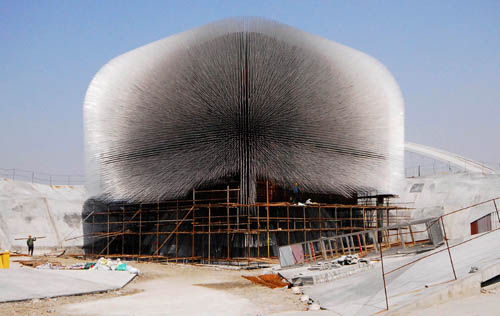 [Image: Thomas Heatherwick's "Seed Cathedral" at the 2010 Shanghai World Expo; photo by Reuters/China Daily, via The Big Picture].
[Image: Thomas Heatherwick's "Seed Cathedral" at the 2010 Shanghai World Expo; photo by Reuters/China Daily, via The Big Picture].I have to admit that, however over-exposed this building might be, it is one of the coolest architectural constructions I've seen in a long time—and while I say that in the most superficial way imaginable, i.e. I just think it looks really, really cool, this structure, the so-called "Seed Cathedral" by Thomas Heatherwick, under construction in Shanghai for this summer's 2010 World Expo, has an amazing ulterior motive: at the end of every one of the 60,000 transparent acrylic rods that you see fuzzing outward into the sunlight are the seeds of plants.
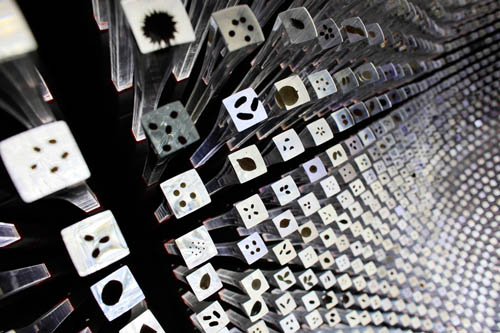 [Image: The seeds revealed; photo by Aly Song for Reuters, via The Big Picture].
[Image: The seeds revealed; photo by Aly Song for Reuters, via The Big Picture].The result looks very much like an expansion of Heatherwick's earlier work Sitooterie II, but the final design also incorporates seeds from the Kew Millennium Seed Bank project.
From the New York Times last autumn: "Heatherwick and his team worked with Kew’s Millennium Seed Bank partnership to showcase Britain’s commitment to conservation. They encased thousands of seeds in the ends of the transparent rods, creating a larger-than-life catalog of the plant species that contribute to national and global conservation programs, in a veritable cathedral of seeds."
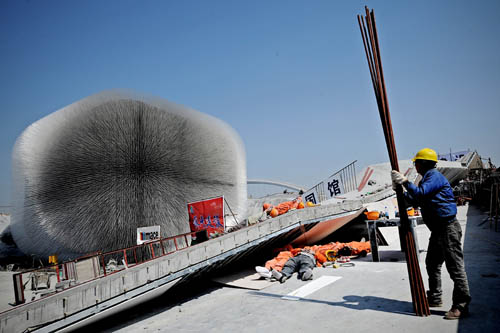
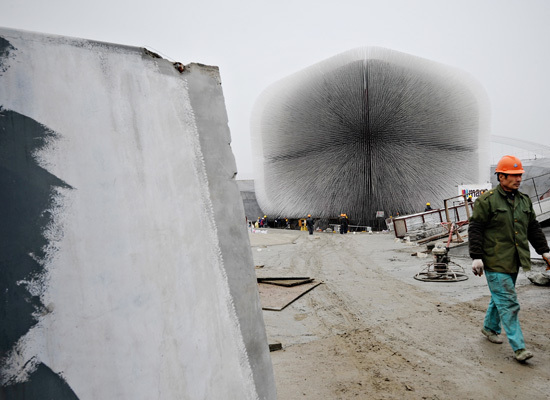

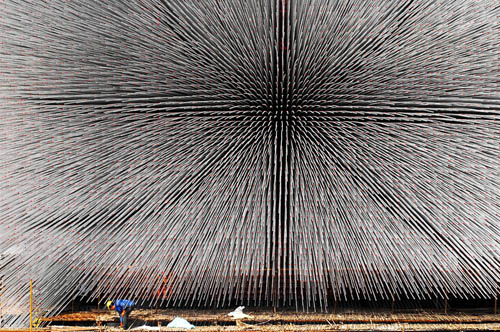 [Images: Thomas Heatherwick's "Seed Cathedral" prepares to open in Shanghai; photos by Philippe Lopez/AFP/Getty Images; STR/AFP/Getty Images; and AP; all via The Big Picture].
[Images: Thomas Heatherwick's "Seed Cathedral" prepares to open in Shanghai; photos by Philippe Lopez/AFP/Getty Images; STR/AFP/Getty Images; and AP; all via The Big Picture].Seed vaults have long been of interest here, of course, but this non-doomsday-inspired celebration of terrestrial botany is, for me, surprisingly much more thrilling than some top secret polar room predicated on an end-of-the-world agricultural scenario. Perhaps every town should have its own seed cathedral, blur-buildings of acrylic rods to showcase their local flora.





Comments are moderated.
If it's not spam, it will appear here shortly!
This is the sort of amazing idea-to-building process that seems to be only possible with our contemporary technologies. It makes me pretty proud to be alive now.
I can see this inspiring a Disneyworld ride /experience with a metallic sphere inside a metallic sphere that are connected, one o those moebius strip type shapes where the poles hold plants, so you go through this reverse planet and can walk along the walls and around with magnetic boots and experience all the foliage of the world, from the pollinator's perspective. Or maybe loop through on an electromagnetic tram. I'm not sure if that makes sense in words but I can definitely see it in my head.
It is awesome, although I'd call it the 'Chia Cathedral.'
i really do enjoy heatherwick's work. i think he's genius in many ways.
however this is unfortunate. um. seeds? that you can barely see? judging from the sheer scale of this installation, i find it quite hard to believe this is a catalog at all. catalogs are meant to be studied at some form of eye level with some form of ease. this would seem like a total pain in the ass, what with transparent acrylic reflecting the overcast sky all over the place. and that's another thing.. if Britain is so bent on showcasing it's ecological self, why the hell use acrylic in the first place? why not bamboo or something found in china?
why not celebrate it as an incredibly novel form making exercise, which it is, and which we will all judge it by.?
what i really want is a quiz at the end of the tour. all passers- by and visitors should answer questions to prove if they actually looked at / or studied the seeds
I agree that it's brilliant. The only nagging fact for me is that the seeds would likely be damaged by UV rays over time, which then defeats any potential purpose as a seed bank. I realize that's not the building's literal purpose, but I wish the seeds could be more than a symbolic presence.
My understanding is that, though the seeds are encased at the ends of these rods, it is actually inside the structure where you can see them in their capsules—so they'd be protected from UV rays and also quite visible for Expo attendees. It is very much and undeniably an imperfect mode of display, and the seeds do feel a bit tacked-on, but I still do like the (admittedly arbitrary) combination of architectural eye candy and botanical catalog.
In any case, I'm reminded of architectural ornament more generally, where you might walk into a building every day for ten years and not notice that, all along, there have been little sandstone sculptures of who knows what—physicists, rare plants, maps of river systems, scientific equipment, even seeds—on the facade above you, but the fact that these details have escaped your notice hardly takes away from their visual interest or poetic impact.
Doesn't this remind anyone else of Star Wars?
This design looks shockingly similar to the Hedgehog Building by Moxon Architects in London: http://travelwithfrankgehry.blogspot.com/2009/04/hedgehog-building.html
Post a Comment